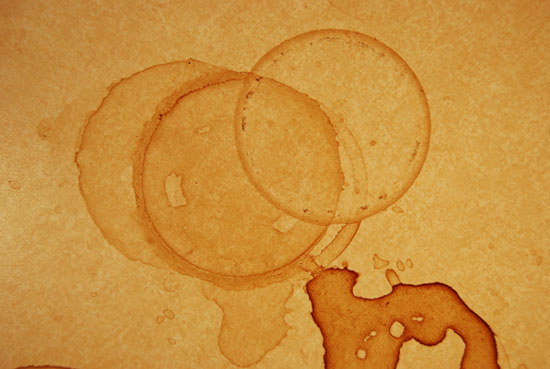Coffee stains: Interesting physical phenomenon
Coffee stains seem to be nothing special, but in fact are an interesting physical phenomenon. US scientists have just made a new discovery, changing their previous conception of the formation of these stains.
According to scientists, liquids, such as coffee, formed from spherical dry coffee beans, will differ from liquids from more elongated shaped particles.

Coffee stains.
Each coffee bean, about one micrometer in size, is about 10,000 times larger than coffee molecules. When a drop of coffee falls and begins to dry, the liquid flows from the middle to the outside to form a certain shape, containing the solid in it. After completely evaporating, this liquid creates a dark halo at the edge of the stain while the middle part is nothing, looking like a ring.
The researchers assume that spherical shaped particles are more spherical and will behave similarly. Therefore, they were surprised to find elongated particles that tend to clump more than spherical particles.The clogging interferes with the flow of liquid from the middle to the edge, thereby distributing solids more uniformly when the liquid evaporates, so that the trace does not have a circular shape with a bold edge like a stain the coffee.
According to Peter Yunker, head of research at the University of Pennsylvania, just changing the shape of the particles without changing the chemical composition can avoid stains and can make many practical applications from existing. This basic physics statue. For example, paint and ink manufacturers can prevent their products from being unevenly dry without the addition of chemical solids.
The cost of ink is even higher than expensive champagne, so if we can reduce the amount of chemical solids in inkjet ink, the cost of producing ink will be much reduced, Yunker said.
- Why is it when the coffee is dry, the stain is colored in light, in addition to bold?
- Revealing an interesting secret about coffee makes you not surprised
- Remove stains with ... carbonated soft drinks
- Comes with self-cleaning clothes
- 10 facts about coffee
- How to make a perfect cup of coffee?
- Eliminate stubborn stains on computer monitors, televisions
- Around the world with 31 types of coffee
- Why are only some places growing the best coffee in the world?
- Applying technology in Mercedes cars, people have created the best coffee filter in the world
- How much does your habit of drinking coffee consume?
- Strange: Tea made from extremely good coffee for health
 'Fine laughs' - Scary and painful torture in ancient times
'Fine laughs' - Scary and painful torture in ancient times The sequence of numbers 142857 of the Egyptian pyramids is known as the strangest number in the world - Why?
The sequence of numbers 142857 of the Egyptian pyramids is known as the strangest number in the world - Why? History of the iron
History of the iron What is alum?
What is alum?